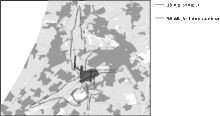Day–evening–night noise level
The day–evening–night noise level or Lden is a 2002 European standard to express noise level over an entire day. It imposes a penalty on sound levels during evening and night[1] and it is primarily used for noise assessments of airports, busy main roads, main railway lines and in cities over 100,000 residents.[2][3][4] The penalty for sound production during evenings and nights is due to higher nuisance perception during quieter hours and to prevent sleep deprivation for nearby residents.

Definition
Lden is calculated as:[5]
Where the long-term average noise levels are defined as:
| Part of the day | hours | penalty (dB) |
|---|---|---|
| day | 07:00 - 19:00 | 0 |
| evening | 19:00 - 23:00 | 5 |
| night | 23:00 - 07:00 | 10 |
The exact hours of the three periods may be chosen differently by individual EU member states.
The formula for Lden can be considered a weighted average of the yearly individual noise level during day, evening and night.
See also
- Environmental noise directive
- Day-night average sound level, the US equivalent
References
- Malcolm J. Crocker (5 October 2007). Handbook of Noise and Vibration Control. John Wiley & Sons. p. 15. ISBN 978-0-471-39599-7.
- "Gesundheitsrisiken durch Umgebungslärm" [Health risks from environmental noise]. Umweltbundesamt. 2 June 2020.
- Daniel R. Raichel (4 January 2006). The Science and Applications of Acoustics. Springer Science & Business Media. p. 331. ISBN 978-0-387-26062-4.
- Norman J. Ashford; Saleh Mumayiz; Paul H. Wright (6 April 2011). Airport Engineering: Planning, Design, and Development of 21st Century Airports. John Wiley & Sons. p. 724. ISBN 978-1-118-00547-7.
- "Directive 2002/49/EC". Act of 25 June 2002.